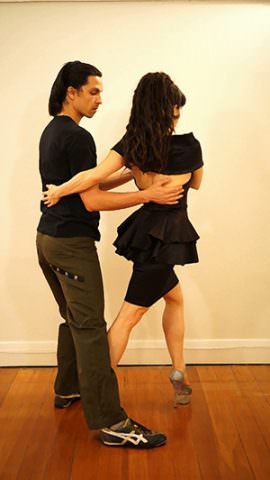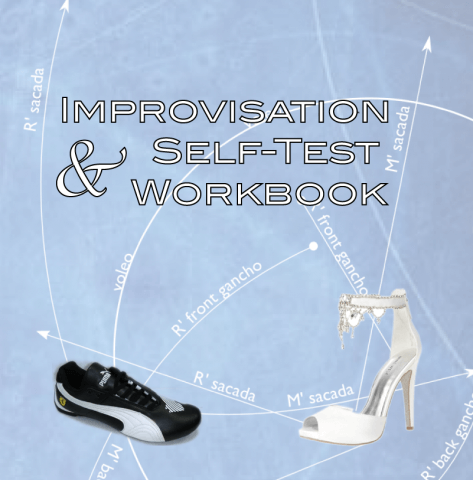What is Tango Improvisation?
Tango improvisation is not about memorizing sequences, it’s about systems. Argentine Tango basic movements, variations, and dynamics offer dancers a rich language of 1000 possibilities for real tango improvisation. These possibilities offer a range of expression for any mood, space, traffic, and music.
A lot of dancers aren’t clear on what it means to “Improvise from the Elements”. It means that the Mark chooses each step spontaneously to express the music, based on the tango vocabulary and space available to him.
Most dancers use few of the 25 tango elements, and less than half of the variations of those elements. This illiteracy is largely due to the tendency of teachers to rely on sequences for teaching (which students can’t remember and therefore don’t use even having paid for them) and the challenges of training Revel/Followers, exacerbated by the misrepresentation of Nuevo Tango as a style (rather than simply a system of analysis). The misundersatnding has been grossly overstimulated by the ascendancy of Fundamentalist Tango which lays claim to the realm of nice experience and inaccurately correlates it with simplistic dancing.
The hegemonic global method of dancing at the moment uses roughly 5 movements (steps, crosses, ochos, rebotes, giros) from our glorious inheritance from the history of Argentine Tango improvisation and generally only half of the possible variations of those movements. It relies on one constant dynamic, which eschews the variation of quality of movement which gets us from hundreds of variations to roughly a thousand movement expressions
Moreover, most people, even “advanced” social dancers are relying on only a handful of sequences. Beginning Revels are quickly numbed into adequate obedience, from which they have a hard time escaping if they happen to dance with some veteran of the virtuous era who doesn’t use those sequences. Marks have a hard time memorizing new sequences, so their dance expands slowly or not at all. (If they do try something new, they are discouraged by Revels who barrel through a familiar sequence anyway.)
Most Marks probably have no idea how much they’re repeating themselves. I do know, I use a stopwatch.
Real Tango Improvisation
No matter how much you think you hate Nuevo Tango, you are the recipient of its gift to the world: the possibility to understand Argentine Tango by its most fundamental elements, ONE step at a time, rather than a sequence of several steps followed by another sequence of several steps.
If you learn to think about tango one step at at time, improvisation becomes easy and your creativity will emerge without memorizing anything!
It means that no matter what foot you are on, and what foot she is on, you can do a tiny delicate cross, a cracking voleo, or a dynamic sacada.
No matter what kind of traffic crisis you are facing, you can find interesting ways to use the space available, get out of the way, change your direction. You have a movement for every space, and you don’t need to remember “how to start that one” because if you use real tango improvisation you initiate an element without a preamble of sequence steps.
If you are aware that you are constantly falling back on dull sequences like front rebote-side step, the standard cross, or 7-8-1 of the 8-count basic (“the evil sequence“), you can force yourself to stop in the first step of one of these sequences and find another way. You can also change the base of your dance to a system that will force you out of your habits (sacadas, double giros).
You can train your improvisation by forcing yourself to use any kind of movement on the different tango pathways: the 3 lines and the 3 circles we use to move in the line of dance.
To grow expressive dynamic, both dancers must increase muscle control to increase the possibility for diverse quality of motion: power, drama, acceleration, and sensitivity and control for transitions and contrast. (How DJ’s accommodate dancers’ lack of muscle control…)
 “But when I do something new it doesn’t work”
“But when I do something new it doesn’t work”
This is a communal problem. We have to stop numbing the revels with sequences if they are going to bother to listen.
But believe me, they are bored. I hear it from from women all the time. “He has such a nice embrace, but he always does the same steps.” Women can feel so much possibility, they are ready for tango improvisation. If you start to trust them (even it means making mistakes), they will be delighted with your efforts.
Of course, they still enjoy dancing with you, but I promise that your partners are ready, willing, and able to be more receptive.
Revel women followers can take action to invite improvisation
Darlings, don’t wait. You can learn to move in a way that creates spacetime that draws your man into exploration.
This way of movement also creates more pleasure in the process of moving.
You are a Divine Time Machine, opening rifts that elicit creativity from your Mark.
Everything we love about traditional tango is better with Real tango improvisation
It’s better for the experience of CONNECTION, which is about mutual concentration. More improvisation means more concentration, which means a more intense experience. When somebody is bored, they are not fully present, and we don’t get to Flow.
It’s better for the EMBRACE, because partners need to maintain more perfect physical contact to communicate better.
It’s better for MUSICALITY, because the same sequences are producing a lot of the same musicality. Change your movements and you’ll find new ways of relating to the music.
It’s better for the RONDA, because if everybody is dancing one step at a time and has a big vocabulary, rather than barrelling into one of only a few sequences available to them, they are more able to manage traffic crises, use changing space, and create delight in very little space.
If you’re ready to learn about systems of improvation, check out the TangoForge KnowledgeBase, a comprehensive encyclopedia of movement variations (with technique for each).
We are thrilled to announce the next step in our work to encourage Real Improvisation from the Elements: A video series in YouTube which shows the systems of variations for every tango movement.
.
Or, watch and follow on your favorite site:





 “But when I do something new it doesn’t work”
“But when I do something new it doesn’t work”










